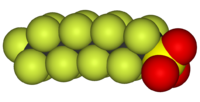
Perfluorononanoate and Perfluorobutane Sulfonate Induce Cardiotoxic Effects in Zebrafish
Sign Up to like & getrecommendations! Published in 2022 at "Environmental Toxicology and Chemistry"
DOI: 10.1002/etc.5447
Abstract: Globally, per‐ and polyfluoroalkyl substances are common artificial ingredients in industrial and consumer products. Recently, they have been shown to be an emerging human health risk. Perfluorononanoic acid (PFNA)/perfluorononanoate and perfluorobutane sulfonic acid (PFBS)/perfluorobutane sulfonate… read more here.
Keywords: toxicology; pfbs; cardiotoxic effects; chemistry ... See more keywords

Accumulation of perfluorobutane sulfonate (PFBS) and impairment of visual function in the eyes of marine medaka after a life-cycle exposure.
Sign Up to like & getrecommendations! Published in 2018 at "Aquatic toxicology"
DOI: 10.1016/j.aquatox.2018.05.018
Abstract: As an alternative to perfluorooctane sulfonate (PFOS), increasing usage of perfluorobutane sulfonate (PFBS) has led to ubiquitous presence in the environment. PFBS is also shown to potently disrupt the thyroid endocrine system. Considering the regulation… read more here.
Keywords: life cycle; exposure; pfbs; cycle exposure ... See more keywords

Interaction between hypoxia and perfluorobutane sulfonate on developmental toxicity and endocrine disruption in marine medaka embryos.
Sign Up to like & getrecommendations! Published in 2020 at "Aquatic toxicology"
DOI: 10.1016/j.aquatox.2020.105466
Abstract: The co-occurrence of hypoxia and xenobiotics is extremely common in natural environments, highlighting the necessity to elicit their interaction on aquatic toxicities. In the present study, marine medaka embryos were exposed to various concentrations (nominal… read more here.
Keywords: pfbs hypoxia; medaka; exposure; pfbs ... See more keywords

Exposure of adult mice to perfluorobutanesulfonate impacts ovarian functions through hypothyroxinemia leading to down-regulation of Akt-mTOR signaling.
Sign Up to like & getrecommendations! Published in 2019 at "Chemosphere"
DOI: 10.1016/j.chemosphere.2019.125497
Abstract: Perfluorobutanesulfonate (PFBS), a short-chain perfluoroalkyl substance, is used in many industrial products. Preliminary evidence suggests that exposure to PFBS may increase the risk of infertility. The aim of this study was to investigate the influence… read more here.
Keywords: pfbs; mice; exposure adult; akt mtor ... See more keywords

Dietary administration of probiotic Lactobacillus rhamnosus modulates the neurological toxicities of perfluorobutanesulfonate in zebrafish.
Sign Up to like & getrecommendations! Published in 2020 at "Environmental pollution"
DOI: 10.1016/j.envpol.2020.114832
Abstract: Perfluorobutanesulfonate (PFBS), an aquatic pollutant of emerging concern, is found to disturb the neural signaling along gut-brain axis, whereas probiotic additives have been applied to improve neuroendocrine function of teleosts. Both PFBS and probiotics can… read more here.
Keywords: probiotic lactobacillus; lactobacillus rhamnosus; pfbs probiotic; pfbs ... See more keywords

Probiotics inhibit the stunted growth defect of perfluorobutanesulfonate via stress and thyroid axes in zebrafish larvae.
Sign Up to like & getrecommendations! Published in 2021 at "Environmental pollution"
DOI: 10.1016/j.envpol.2021.118013
Abstract: Perfluorobutanesulfonate (PFBS) is an emerging pollutant in aquatic environments and potently disrupts the early developmental trajectory of teleosts. Considering the persistent and toxic nature of PFBS, it is necessary to develop in situ protective measures… read more here.
Keywords: zebrafish larvae; pfbs; stress; growth ... See more keywords

Pharmacokinetic profile of Perfluorobutane Sulfonate and activation of hepatic nuclear receptor target genes in mice.
Sign Up to like & getrecommendations! Published in 2020 at "Toxicology"
DOI: 10.1016/j.tox.2020.152522
Abstract: Per- and polyfluoroalkyl substances (PFAS) are organic chemicals with wide industrial and consumer uses. They are found ubiquitously at low levels in the environment and are detectable in humans and wildlife. Perfluorobutane Sulfonate (PFBS) is… read more here.
Keywords: perfluorobutane sulfonate; pfbs; hepatic nuclear; nuclear receptor ... See more keywords